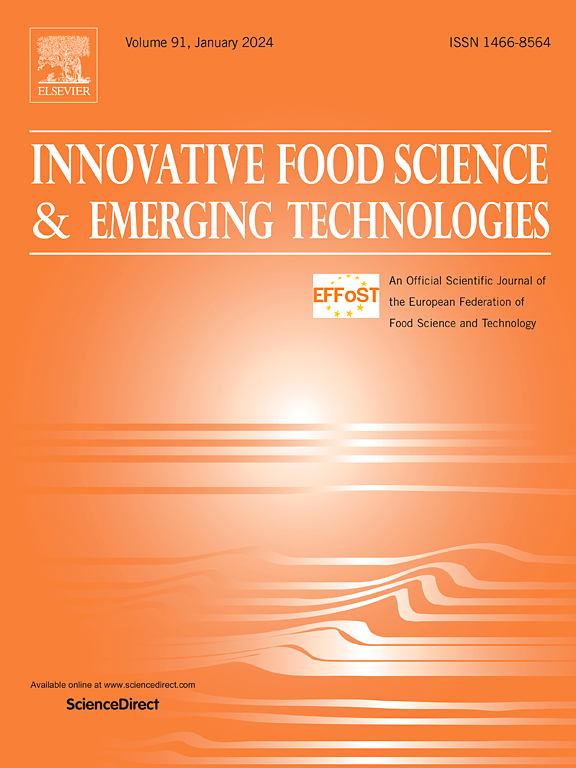浓相二氧化碳和巴氏灭菌处理对番石榴果泥贮藏品质的影响
IF 6.3
1区 农林科学
Q1 FOOD SCIENCE & TECHNOLOGY
Innovative Food Science & Emerging Technologies
Pub Date : 2025-02-08
DOI:10.1016/j.ifset.2025.103944
引用次数: 0
摘要
番石榴是抗氧化剂、其他植物化学物质和膳食纤维的良好来源。保存番石榴泥的传统方法是高温巴氏杀菌,它会降解某些对人体健康有益的成分。本研究的目的是确定用稠密相二氧化碳(DPCD)法对番石榴泥进行巴氏灭菌的最佳条件(压力、二氧化碳含量和停留时间)。实验测量了在压力为6.9 ~ 31.03 MPa、温度为35℃的条件下,果浆中CO2的溶解量。实验结果与过程模拟软件Aspen Plus®评估的平衡条件进行了比较。在压力为34.1 MPa、CO2含量为8%、停留时间为6.9 min的条件下,酵母和霉菌数量以及好氧平板数量的对数降低≥3.2。番石榴果泥在4°C冷藏14周内微生物稳定。DPCD样品的pH值与新鲜样品相似,但可滴定酸度高于未经处理的样品。经DPCD处理的果浆粘度和云损失均有所增加。果胶酯酶活性部分失活,降低20%。与热巴氏灭菌相比,DPCD处理可以用作非热处理,而不会使产品质量恶化。本文章由计算机程序翻译,如有差异,请以英文原文为准。
Influence of dense phase carbon dioxide and pasteurization treatments on storage quality of guava puree
Guava is a good source of antioxidants and other phytochemicals, and dietary fiber. The traditional method for preserving guava puree is heat pasteurization, which degrades certain constituents that are beneficial to human health. The objective of this study was to determine the optimal conditions (pressure, % carbon dioxide, and residence time) for the pasteurization of guava puree by Dense Phase Carbon Dioxide (DPCD) process. The amount of CO2 solubilized in the puree was measured experimentally in the range of pressure from 6.9 to 31.03 MPa at 35 °C. The experimental results were compared with the equilibrium conditions evaluated using the process simulation software Aspen Plus®. A log reduction ≥3.2 was achieved for yeast and mold count and aerobic plate count using 34.1 MPa pressure, 8 % CO2 and a residence time of 6.9 min. Guava puree was microbiologically stable during 14 weeks of refrigerated storage at 4 °C. DPCD samples showed pH similar to fresh samples but the titratable acidity for the DPCD was higher than the untreated ones. Increases in viscosity and cloud loss were observed for the DPCD treated puree. In addition, pectinesterase activity was partially inactivated reaching 20 % reduction. DPCD processing can be used as a non-thermal treatment without deteriorating the quality of the product compared to heat pasteurization.
求助全文
通过发布文献求助,成功后即可免费获取论文全文。
去求助
来源期刊
CiteScore
12.00
自引率
6.10%
发文量
259
审稿时长
25 days
期刊介绍:
Innovative Food Science and Emerging Technologies (IFSET) aims to provide the highest quality original contributions and few, mainly upon invitation, reviews on and highly innovative developments in food science and emerging food process technologies. The significance of the results either for the science community or for industrial R&D groups must be specified. Papers submitted must be of highest scientific quality and only those advancing current scientific knowledge and understanding or with technical relevance will be considered.

 求助内容:
求助内容: 应助结果提醒方式:
应助结果提醒方式:


